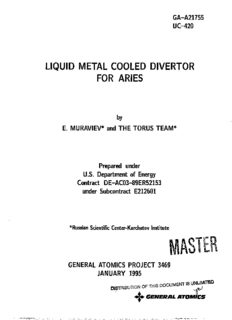
liquid metal cooled divertor for aries PDF
Preview liquid metal cooled divertor for aries
GA-A21755 UC-420 LIQUID METAL COOLED DIVERTOR FOR ARIES by E. MURAVIEV* and THE TORUS TEAM* Prepared under U.S. Department of Energy Contract DE-AC03-89ER52153 under Subcontract E212601 * Russian Scientific Center-Kurchatov Institute GENERAL ATOMICS PROJECT 3469 JANUARY 1995 3TR,BUT,ONOPTH,SOOCUME^.SUNUMrTB Di 0 <*|* GENERAL ATOMICS DISCLAIMER This report was prepared as an account of work sponsored by an agency of the United States Government. Neither the United States Government nor any agency thereof, nor any of their employees, make any warranty, express or implied, or assumes any legal liability or responsibility for the accuracy, completeness, or usefulness of any information, apparatus, product, or process disclosed, or represents that its use would not infringe privately owned rights. Reference herein to any specific commercial product, process, or service by trade name, trademark, manufacturer, or otherwise does not necessarily constitute or imply its endorsement, recommendation, or favoring by the United States Government or any agency thereof. The views and opinions of authors expressed herein do not necessarily state or reflect those of the United States Government or any agency thereof. DISCLAIMER Portions of this document may be illegible in electronic image products. Images are produced from the best available original document. Russian Scientific Center Kurchatov institute Small Enterprise TORUS "Approved" General Director of TORUS / y\^yj^ V. Shchedrov ' >'*>'<2P. <9$ »» 1 9 93 LIQUID METAL COOLED DIVERTOR FOR ARIES Final Report of the Design Study Principal Investigator /tv^'T^py, E.Muraviev "il? ^ 1993 Work has been done by a group of specialists from Institute of Nuclear Fusion of Russian Scientific Center Kurchatov Institute as a temporary working team of Small Enterprise TORUS within the scope of subcontract No.E212601 with General Atomics, San Diego, CA, USA Moscow, August 1993 ABSTRACT A liquid metal, Ga-cooled divertor design was completed for the double null ARIES-II divertor design. The design analysis indicated a surface heat flux removal capability of up to 15 MW/m2, and its relative easy of maintenance. Design issues of configuration, thermal hydraulics, thermal stresses, liquid metal loop and safety effects were evaluated. For coolant flow control, it was found taht it is necessary to use some part of the blanket cooling ducts for the draining of liquid metal from the top divertor. In order to minimize the inventory of Ga, it was recommended that the liquid metal loop equipment should be located as close to the torus as possible. More detailed analysis of transient conditions especially under accident conditions was identified as an issue that will need to be addressed. iii TABLE OF CONTENTS Abstract iii Preface ix 1. Introduction 1-1 References for Section 1 1-4 2. General Concept Description 2-1 2.1. Liquid Metal Selection 2-1 2.2. Key Features of the Concept 2-4 2.3. Summary of the Design Parameters 2-8 2.4. Critical Design Issues 2-11 References for Section 2 2-12 3. Materials Review 3-1 3.1. General Materials Compatibility with Gallium 3-1 3.2. Corrosion Resistance of Structural Materials 3-2 3.3. Thermo-Mechanical Properties of the Selected Vanadium Alloy . . .. 3-6 References for Section 3 3-7 4. Description of the Divertor Design 4-1 4.1. Double-Null Divertor Configuration Lay-Out 4-1 4.2. Divertor Targets Design 4-2 4.2.1. High Heat Flux Targets 4-2 4.2.2. Low Heat Flux Targets 4-2 4.3. In-Reactor Module Design 4-3 4.3.1. Rectangular Module 4-3 4.3.2. LM Sink Devices of the Module Drain Pipes 4-4 4.3.3. Trapezium Module 4-5 4.4. Overall Gallium Loop Layout 4-5 References for Section 4 4-24 5. In-Reactor Thermal Hydraulics 5-1 5.1. Thermal Loads and Flow Rates Distribution 5-1 V 5.2. Film Flow MHD-Braking 5-3 5.3. Flow Regimes and Heat Transfer Coefficients 5-3 5.4. MHD Pressure Losses and LM Self-Draining 5-8 5.4.1. General Points 5-8 5.4.2. Key Relations 5-10 5.4.3. Calculation Results 5-13 References for Section 5 5-17 6. Thermal-Stress Analysis 6-1 6.1. High Heat Flux Targets 6-1 6.2. Low Heat Flux Targets 6-5 7. Liquid Metal Loop Evaluation 7-1 7.1. Some Requirements and Initial Data 7-1 7.2. Heat Exchangers 7-2 7.3. Tritium Processing 7-4 7.3.1. Initial Data 7-4 7.3.2. Tritium Accumulation in Gallium Coolant 7-5 7.4. Liquid Metal Conditioning 7-8 7.4.1. Impurity Sources 7-8 7.4.2. Requirements to the Impurity Content in LM 7-8 7.4.3. Gallium Cleaning 7-9 7.5. Pumps 7-11 7.5.1. General Considerations 7-11 7.5.2. Pumping Requirements 7-12 References for Section 7 7-14 8. Safety Consideration 8-1 8.1. Accident Scenarios 8-1 8.1.1. Loss of Coolant Flow Accident 8-1 8.1.2. Loss of Coolant Accident 8-1 8.1.3. Other Accidents 8-2 8.1.4. Some Preliminary Conclusions 8-3 8.2. Activation and After Heat Dynamics 8-6 8.2.1. Initial Points 8-6 8.2.2. Composition 8-8 vi 8.2.3. Calculation Results 8-9 8.3. Accident Analysis 8-16 8.3.1. Loss of Coolant Flow Accident 8-16 8.3.2. Loss of Coolant Accident 8-17 8.3.3. Conclusions 8-20 8.4. Tritium Dose Estimate at Gallium Spilling Accident 8-20 References for Section 8 8-23 9. Conclusions 9-1 Acknowledgments 10-1 List of Authors 11-1 vii
Description: